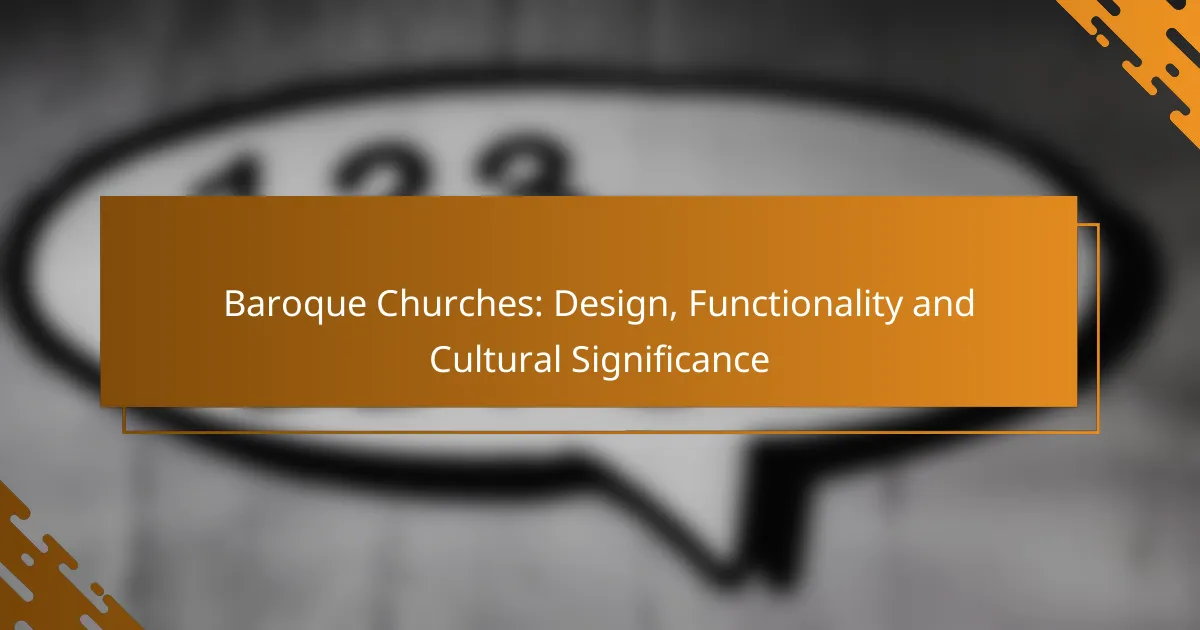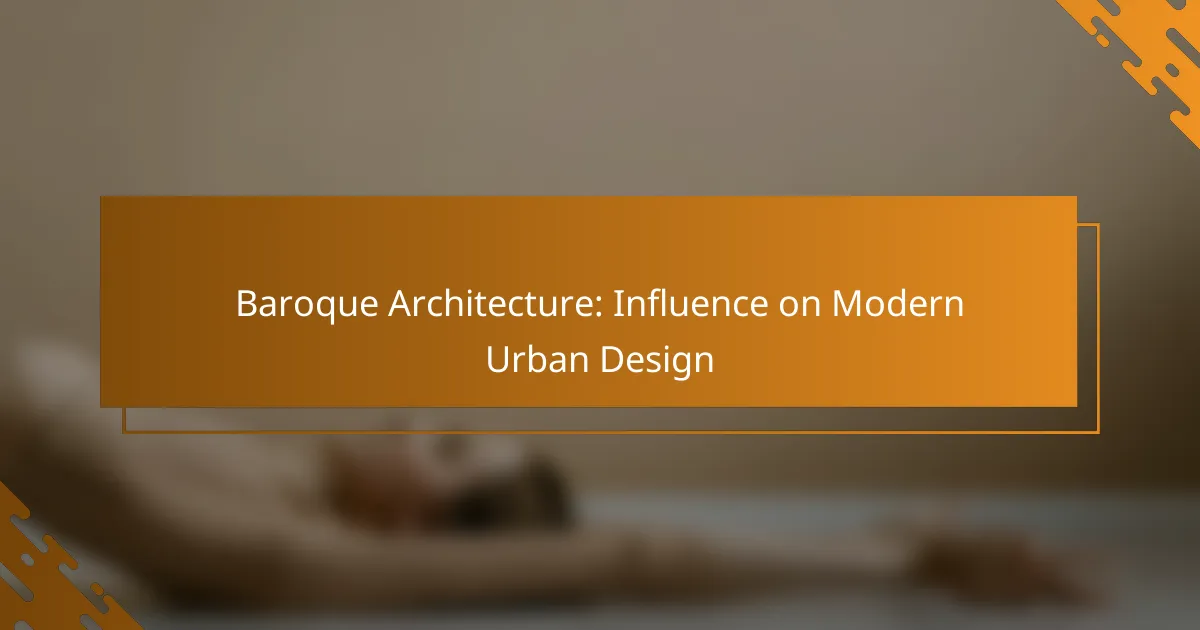Baroque architecture, known for its grandeur and intricate details, can transform home design into a realm of opulence and elegance. By incorporating ornate elements and dramatic spatial arrangements, homeowners can create visually stunning environments that also enhance functionality. This timeless style not only elevates aesthetic appeal but can also increase property value, making it a compelling choice for modern living spaces.
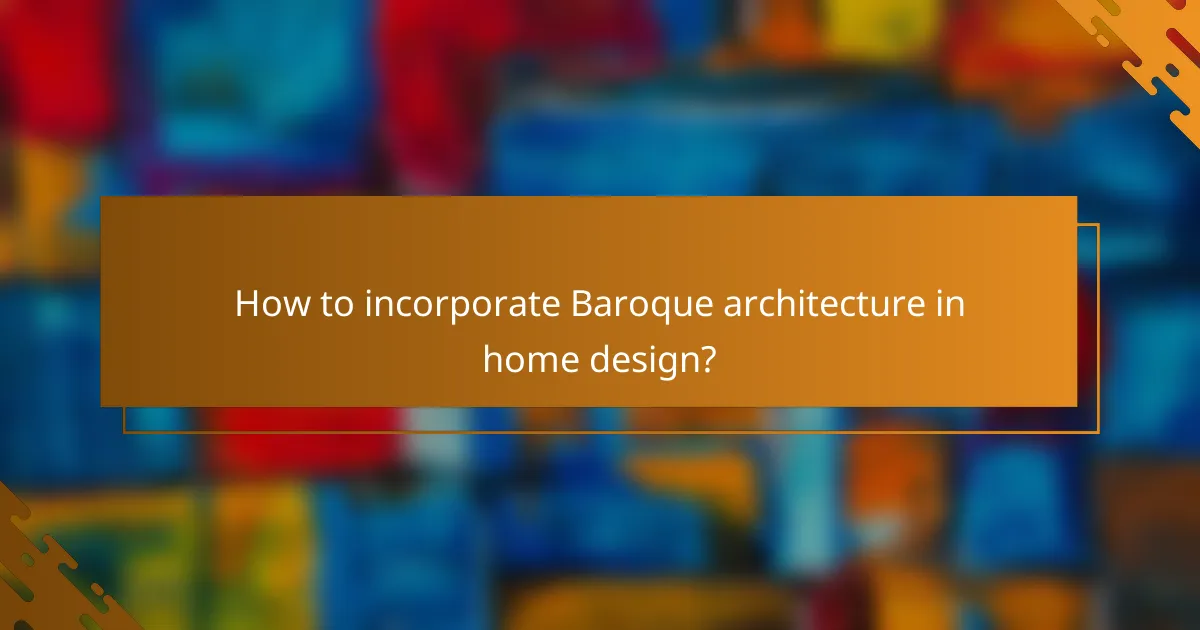
How to incorporate Baroque architecture in home design?
Incorporating Baroque architecture into home design involves embracing its characteristic grandeur and intricate details. Focus on ornate elements, dramatic staircases, and a balanced layout to create a space that reflects this opulent style.
Use of ornate details
Ornate details are a hallmark of Baroque architecture, characterized by elaborate moldings, decorative ceilings, and intricate woodwork. Consider incorporating features such as crown molding, ceiling medallions, and embellished door frames to enhance the visual richness of your home.
Choose materials that reflect luxury, such as marble, gilded accents, and rich textiles. These elements can be used in various areas, including living rooms, dining areas, and hallways, to create a cohesive design that captures the essence of Baroque aesthetics.
Incorporating grand staircases
Grand staircases are a signature feature of Baroque architecture, often serving as a focal point in a home. When designing a staircase, opt for sweeping curves, elaborate railings, and a wide, open layout to evoke a sense of grandeur.
Materials like wrought iron or polished wood can enhance the staircase’s elegance. Consider adding decorative elements such as chandeliers above the staircase or artwork along the walls to further emphasize its importance in your home design.
Utilizing symmetry and proportion
Symmetry and proportion are essential in Baroque architecture, creating a sense of harmony and balance. When planning your space, ensure that furniture arrangements, window placements, and architectural features are symmetrical to achieve this effect.
Use proportional scaling for furniture and decor to maintain visual balance. For example, large pieces of furniture should be paired with equally substantial decor elements to avoid a disjointed appearance, enhancing the overall cohesiveness of the design.

What are the key characteristics of Baroque architecture?
Baroque architecture is characterized by its grandeur, dramatic use of space, and intricate details. Key features include elaborate ornamentation, dynamic shapes, and a striking interplay of light and shadow.
Elaborate ornamentation
Elaborate ornamentation is a hallmark of Baroque architecture, showcasing intricate details that enhance visual impact. This can include decorative elements such as sculptures, frescoes, and gilded finishes that create a sense of opulence.
Common materials used for ornamentation include marble, stucco, and gold leaf. Buildings like St. Peter’s Basilica in Vatican City exemplify this characteristic with their lavishly decorated interiors and exteriors.
Dynamic shapes and forms
Dynamic shapes and forms in Baroque architecture often feature curves and irregularities that create a sense of movement. Unlike the rigid lines of Renaissance architecture, Baroque designs embrace fluidity, with oval and elliptical shapes being prevalent.
This approach can be seen in structures such as the Palace of Versailles, where the layout and façade are designed to evoke a feeling of grandeur and dynamism. The use of domes and vaulted ceilings further enhances this characteristic.
Contrast between light and shadow
The contrast between light and shadow is a critical element in Baroque architecture, used to create dramatic effects and highlight architectural features. This technique, known as chiaroscuro, enhances the three-dimensionality of structures.
Architects often designed buildings with deep recesses and projecting elements to maximize this contrast. For example, the use of large windows allows natural light to flood in, illuminating ornate details while casting shadows that add depth and intrigue.

What are the benefits of Baroque design in modern homes?
Baroque design offers several benefits for modern homes, including striking visual appeal, increased property value, and a sense of timeless elegance. These features can enhance both the aesthetic and functional aspects of living spaces.
Enhanced aesthetic appeal
Baroque architecture is characterized by dramatic details, bold colors, and intricate designs that create a visually stunning environment. Incorporating these elements into modern homes can transform ordinary spaces into extraordinary ones, making them more inviting and memorable.
Consider using ornate moldings, grand staircases, and elaborate ceiling designs to achieve this aesthetic. These features not only serve as focal points but also reflect a unique style that stands out in contemporary neighborhoods.
Increased property value
Homes designed with Baroque elements often see a boost in property value due to their distinctive style and craftsmanship. Buyers are frequently drawn to unique architectural features that set a home apart from others in the market.
Investing in Baroque design can yield significant returns, particularly in upscale neighborhoods where such styles are appreciated. Features like custom woodwork and high-quality finishes can enhance the overall marketability of a property.
Timeless elegance
The elegance of Baroque design transcends trends, making it a lasting choice for homeowners. This style embodies a sense of grandeur and sophistication that remains appealing across generations.
When integrating Baroque elements, focus on classic materials such as marble, rich woods, and luxurious fabrics. These choices not only contribute to the timeless quality of the design but also ensure that the home retains its charm and appeal over time.
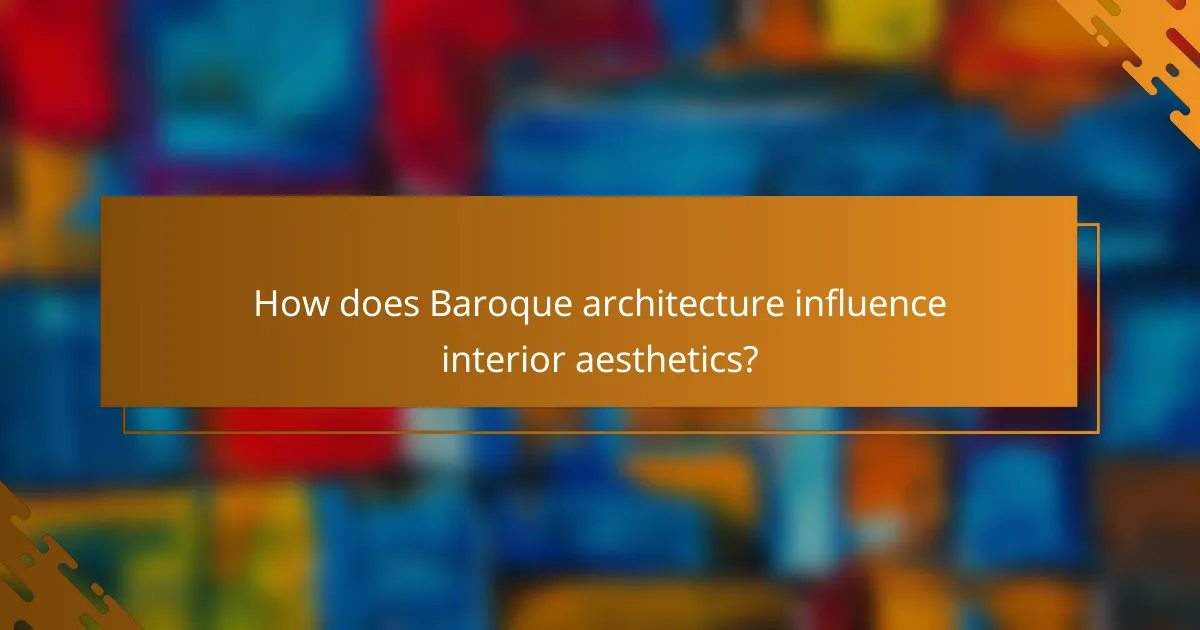
How does Baroque architecture influence interior aesthetics?
Baroque architecture significantly impacts interior aesthetics by emphasizing grandeur, drama, and opulence. Its influence is evident in the use of elaborate details, rich colors, and a sense of movement within spaces, creating an immersive experience.
Rich color palettes
Baroque interiors often feature rich color palettes that evoke warmth and luxury. Deep reds, vibrant golds, and lush greens are commonly used to create dramatic contrasts and enhance the overall opulence of a space. These colors can be applied through wall paint, upholstery, and decorative elements.
When selecting colors, consider using a base of darker hues complemented by brighter accents. This approach not only adds depth but also aligns with the Baroque emphasis on visual richness. For instance, a deep burgundy wall can be paired with gold-framed mirrors and lush green drapes for a striking effect.
Luxurious materials
Baroque design prioritizes the use of luxurious materials to convey wealth and sophistication. Common materials include marble, velvet, and intricate woodwork, which contribute to the tactile and visual richness of the interiors. These materials are often used in furniture, flooring, and decorative features.
Incorporating luxurious materials can elevate the aesthetic of a space. For example, a marble fireplace or velvet upholstery can serve as focal points that draw attention and admiration. When selecting materials, ensure they not only look exquisite but also harmonize with the overall design theme.
Statement furniture pieces
Statement furniture pieces are essential in Baroque interiors, serving as both functional items and works of art. These pieces often feature elaborate carvings, gilded finishes, and bold silhouettes that command attention. Think of large, ornate chairs or intricately designed tables that embody the Baroque spirit.
When choosing statement furniture, focus on items that reflect the grandeur of the Baroque style. Consider investing in a few key pieces that can anchor the room, such as a grand chandelier or an intricately carved sideboard. These elements not only enhance the aesthetic but also provide a sense of history and character to the space.
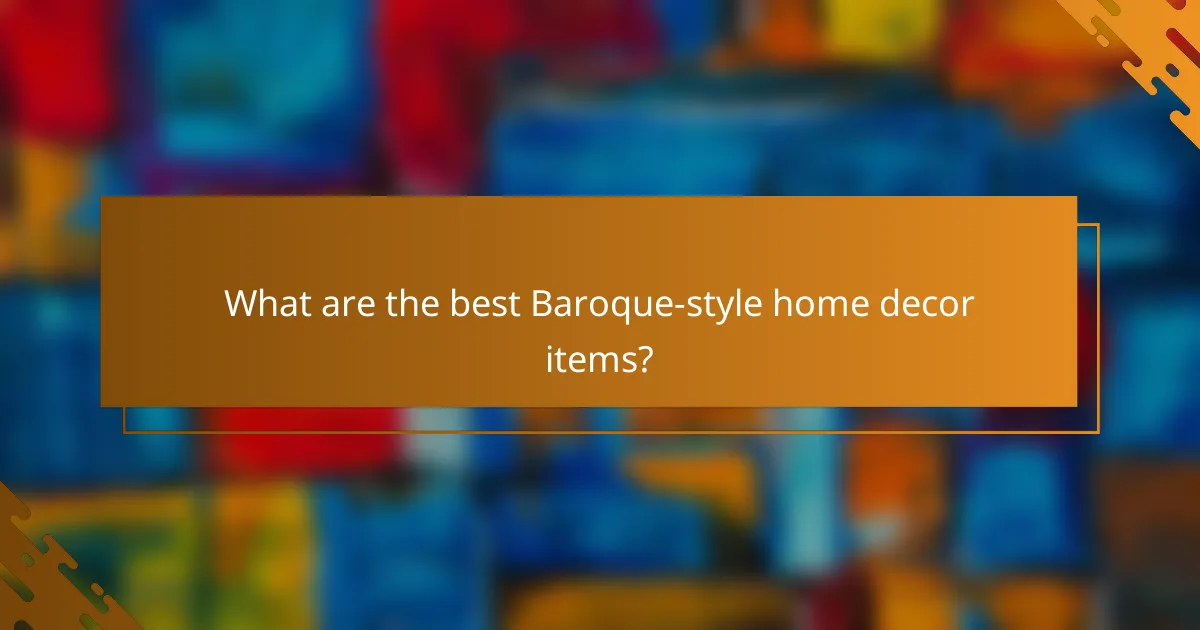
What are the best Baroque-style home decor items?
The best Baroque-style home decor items emphasize grandeur, opulence, and intricate detailing. Key pieces include elaborate chandeliers, decorative mirrors, and richly designed furniture that reflect the dramatic aesthetics of the Baroque period.
Chandeliers and lighting fixtures
Baroque chandeliers are often the centerpiece of a room, featuring multiple arms, ornate details, and sometimes crystals that catch the light beautifully. When selecting a chandelier, consider sizes that fit your space; larger rooms may require fixtures that are several feet wide, while smaller areas benefit from more modest designs.
In addition to chandeliers, wall sconces and table lamps in Baroque style can enhance the overall ambiance. Look for pieces with gold or silver finishes and intricate patterns to maintain the luxurious feel of the decor.
Decorative mirrors
Decorative mirrors in Baroque style are characterized by elaborate frames, often made from gilded wood or adorned with carvings. These mirrors not only serve a functional purpose but also act as striking decorative elements that can enhance the perceived space in a room.
When choosing mirrors, consider their placement to maximize light and create a sense of depth. Large, statement mirrors can be used as focal points in entryways or living rooms, while smaller versions can complement furniture pieces in more intimate settings.
Baroque-style furniture
Baroque-style furniture is known for its rich materials, intricate carvings, and bold colors. Look for pieces made from dark woods like mahogany or walnut, often embellished with gold leaf or detailed upholstery to capture the essence of the period.
Key furniture items include opulent sofas, ornate coffee tables, and grand dining sets. Ensure that the scale of the furniture matches your space; oversized pieces can dominate smaller rooms, while more delicate items can get lost in larger areas. Aim for a cohesive look by coordinating fabrics and finishes across your furnishings.
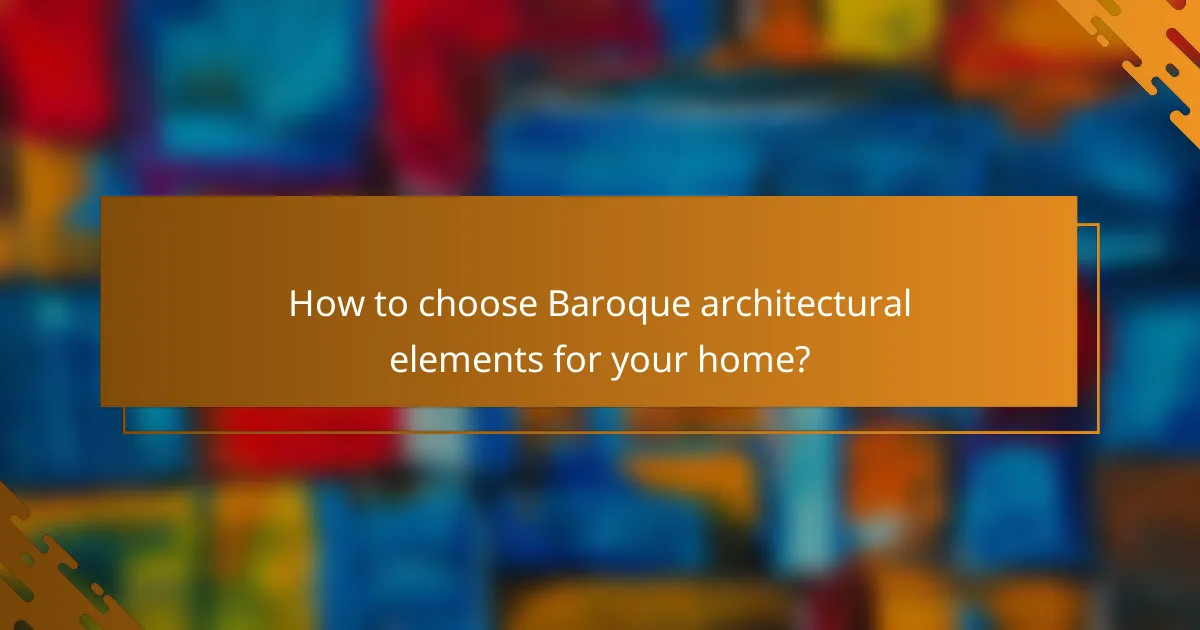
How to choose Baroque architectural elements for your home?
Choosing Baroque architectural elements for your home involves understanding the style’s grandeur and intricate details. Focus on key features such as symmetry, elaborate ornamentation, and dramatic contrasts to create an authentic Baroque aesthetic.
Assessing space and scale
When incorporating Baroque elements, start by assessing the space and scale of your home. Baroque architecture is characterized by its bold proportions and expansive layouts, so ensure your rooms can accommodate larger features like grand staircases or ornate ceilings.
Consider the height and width of your spaces. For instance, high ceilings can benefit from large chandeliers or detailed cornices, while smaller areas might require more subtle touches, such as decorative moldings or wall panels that reflect Baroque style without overwhelming the space.
As a guideline, aim for a balance where the scale of the architectural elements complements the overall dimensions of your rooms. Avoid overcrowding by selecting a few standout pieces, such as a statement fireplace or an intricately designed door, to maintain the elegance of the Baroque style.

